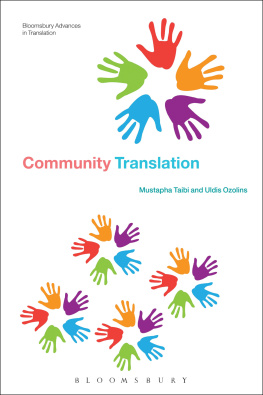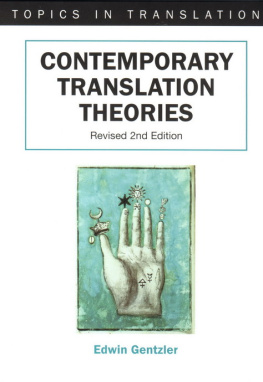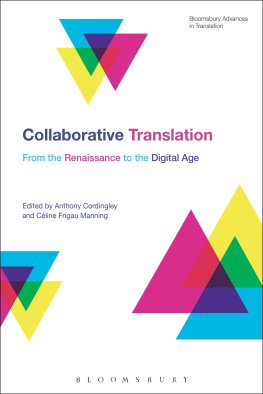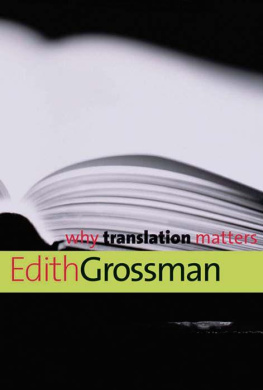Community
Translation
BLOOMSBURY ADVANCES IN TRANSLATION SERIES
Series Editor: Jeremy Munday, Centre for Translation Studies, University of Leeds, UK
Bloomsbury Advances in Translation Studies publishes cutting-edge research in the fields of translation studies. This field has grown in importance in the modern, globalized world, with international translation between languages a daily occurrence. Research into the practices, processes and theory of translation is essential and this series aims to showcase the best in international academic and professional output.
OTHER TITLES IN THE SERIES:
Corpus-Based Translation Studies , Edited by Alet Kruger, Kim Wallmach and Jeremy Munday
Global Trends in Translator and Interpreter Training , Edited by Sverine Hubscher-Davidson and Micha Borodo
Music, Text and Translation , Edited by Helen Julia Minors
Quality in Professional Translation , Joanna Drugan
Retranslation , Sharon Deane-Cox
The Pragmatic Translator , Massimiliano Morini
Translation, Adaptation and Transformation , Edited by Laurence Raw
Translation and Translation Studies in the Japanese Context , Edited by Nana Sato-Rossberg and Judy Wakabayashi
Translation as Cognitive Activity , Fabio Alves and Amparo Hurtado Albir
Translating for Singing , Mark Herman and Ronnie Apter
Translation, Humour and Literature , Edited by Delia Chiaro
Translation, Humour and the Media , Edited by Delia Chiaro
Translating the Poetry of the Holocaust , Jean Boase-Beier
To Jabir
To Kallena Kucers
Community
Translation
MUSTAPHA TAIBI
and uldis ozolins
Bloomsbury Advances in Translation
Bloomsbury Academic
An imprint of Bloomsbury Publishing Plc
Contents
W e would like to thank our colleagues Eva Melhem, Chris Quan, Leong Ko and Richard Yu for their assistance with resources for the last chapter of this book. Our thanks also go to Sedat Mulayim for textual examples from the field. We similarly appreciate Maroua Bounfaats help with the figures. A final word of appreciation goes to Gurdeep Mattu and Andrew Wardell (Bloomsbury) and to Prof. Jeremy Munday, the series editor, for their encouragement, understanding and suggestions.
C ommunity translation both as a practice and as a field of investigation is a relatively new addition to the spectrum of translation studies, and as the first substantial published book on this topic, this publication is as much an exploration as a definitive study of the genre. The field of community translation, as fixed in this book, covers translation not for readers in different countries and cultures to that of the original text, but translations made largely for readers within a country or region. These translations are necessitated above all by the post-World War II phenomenon of massive population shifts as a result of immigration, either peaceful or forced, as well as other movements of people with different languages such as temporary visitors or changes in the status of indigenous languages in some countries. Information needs for these various target readerships are paramount whether for the stream of multilingual visitors visiting a place of pilgrimage, or information on health or other aspects of the institutional system of a country for immigrants or the indigenous population. Yet while primarily a means of conveying host society information to minorities, the translation of such material is often far from straightforward.
Community translation as a genre is still finding its niche in translation studies, but it is related to the somewhat better known and better established practice of community interpreting. Significantly however, while the kind of interpreting known as community interpreting or its various descriptions as liaison, dialogue or public service interpreting is by far the most prevalent form of interpreting in the world, and is an increasingly professionalized area of activity, community translation is dwarfed by the market for technical, business, governmental and literary translation. Community translation is a niche activity, but one that is growing in importance, particularly in the context of increasing immigration and the exponentially increasing need for translation often in languages not of wide diffusion.
However, while the radical linguistic diversity is apparent in community translation as it is in community interpreting, a great deal of community translation is also needed in widely diffused languages in English, in Chinese in its varieties, in Arabic or Spanish or French. Very often for these languages there will be trained practitioners, who may also work seamlessly from community translation to international translation needs. When dealing with languages of limited diffusion and little translation training for practitioners, such as is the case for minor African or smaller Asian languages, then significant issues of professionalism and translation project management arise, which we address in detail.
Some of the issues raised in relation to less widely diffused languages may make it tempting to put translation into these languages into the too-hard basket. Yet a useful counter to such a view is provided by Wallmach and Kruger, who, commenting on translation needs in African indigenous languages, question the oft-perceived gap between translation in this case of African indigenous languages and translation between European languages:
If one views translation as a mirror image of the original, then it is true that this exactness cannot be achieved in the African languages but the same goes for European languages. Linguistic and cultural differences between languages make it necessary to broaden the notion of translation to a more functional approach which includes adaptation and reformulation. (Wallmach and Kruger 1999: 276)
Outside the strictly technical or literary sphere of translation between major world languages, we would argue that indeed all pragmatic translation must strive to present information, persuasion or warnings about many aspects of life that are not immediately familiar to readers. This is particularly the case where the texts to be translated relate to the social, administrative, institutional and cultural areas of life. Social security systems may not exist in some countries; healthcare is organized differently across the globe; legal regimes and legal roles differ widely; education is (more or less) universal but differs radically in organization and processes, and moreover, many who may be required to translate educational material from a host society have never themselves gone through that societys educational system, which challenges their understanding. Adaptation and reformulation, and the quality assurance processes that must attend this endeavour, will emerge as major themes in this book.
One other unique feature of the community translation environment is the already mentioned perspective that community translation, rather than translation for an international audience, is translation largely for the residents of the country from which the source text originates: those residents without command of the dominant language. This demands a particular alertness on the part of community translators to the characteristics of this readership: depending on how long the particular readership has resided in the host society, they too are inevitably shaped by the culture, institutions and languages of that host society. Often imperceptibly to the residents themselves, their cultural orientations and even their languages diverge over time from those in their former homeland, in the cases of immigrants. Indigenous populations have often also been heavily influenced by the larger majority society. The relation of the community translator to this readership is then a complex one, for they are not translating between two distinct languages and cultures, but between a host language/culture and a language/culture of immigrants or the indigenous that over time has been strongly influenced by the host society itself. This can be diagrammatically represented as follows:











